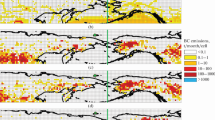Abstract
Data on black carbon (BC) concentration CBC in the air basin of Moscow, and 5-day back trajectories of air mass motion, obtained in the period of 2003–2014, were used to determine the dependence of variations in black carbon concentration in the air basin of Moscow on the direction of air mass transport, and to determine the black carbon source regions. The 12-year measurements of black carbon concentration in Moscow air are used to show that the СBC variations are determined by the character of the air mass circulation in the troposphere. Measurements of black carbon content in the Moscow air basin in June–September 2019 and 10-day back trajectories of air mass transport were used to study the effect of the latter on the air pollution level in Moscow.




Similar content being viewed by others
REFERENCES
G. S. Golitsyn, E. I. Grechko, Van, Genchen, Van, Pusai, A. V. Dzhola, A. S. Emilenko, V. M. Kopeikin, V. S. Rakitin, A. N. Safronov, and E. V. Fokeeva, “Studying the pollution of Moscow and Beijing atmospheres with carbon monoxide and aerosol,” Izv., Atmos. Ocean. Phys. 51 (1), 1–11 (2015).
O. V. Rattigan, A. Carpenter, K. Civerolo, and D. Felton, “Pollutant measurements at near road and urban background sites in New York, USA,” Atmos. Poll. Res. 11 (5), 859–870 (2020).
Wang Yang, Liu Szeling, Shi Peng, Li Yanli, Mu Chao, and Du Ke, “Temporal variation of mass absorption efficiency of black carbon at urban and suburban locations,” Aer. Air Qual. Res. 13 (1), 275–286 (2013).
Quan Jiannong, Dou Youjun, Zhao Xiujuan, Liu Quan, Sun Zhaobin, Pan Yubing, Jia Xingcan, Cheng Zhigang, Ma Pengkun, Su Jie, Xin Jinyuan, and Liu Yangang, “Regional atmospheric pollutant transport mechanisms over the North China Plain driven by topography and planetary boundary layer processes,” Atmos. Environ. 221, 117098 (2020).
O. Alizadeh-Choobari, A. A. Bidokhti, P. Ghafarian, and M. S. Najafi, “Temporal and spatial variations of particulate matter and gaseous pollutants in the urban area of Tehran,” Atmos. Environ. 141, 443–453 (2016).
N. Elansky, “Air quality and CO emissions in the Moscow megacity,” Urban Clim., No. 8, 42–56 (2014).
D. P. Gubanova, I. B. Belikov, N. F. Elansky, A. I. Skorokhod, and N. E. Chubarova, “Variations in PM2.5 surface concentration in Moscow according to observations at MSU meteorological observatory,” Atmos. Ocean. Opt. 31 (3), 290–299 (2018).
R. M, Vil’fand, I. N. Kuznetsova, I. Yu. Shalygina, A. M. Zvyagintsev, M. I. Nakhaev, P. V. Zakharova, and V. A. Lapchenko, “Monitoring and forecasting the air quality in the Moscow region,” Biosfera 6 (4), 339–351 (2014).
Risks of Health Problems for Population due to Vehicle Pollution of the Atmosphere. Experience of Use of a Technique for Risk Assessment in Russia, Ed. by V.A. Petrukhin (Nauka, Moscow, 2000) [in Russian].
V. M. Kopeikin, G. S. Golitsyn, Van, Genchen’, Van, Putsai, and T. Ya. Ponomareva, “Variations in soot concentrations in the megalopolises of Beijing and Moscow,” Atmos. Ocean. Opt. 32 (5), 540–544 (2019).
E. G. Semutnikova, G. I. Gorchakov, S. A. Sitnov, V. M. Kopeikin, A. V. Karpov, I. A. Gorchakova, T. Ya. Ponomareva, A. A. Isakov, R. A. Gushchin, O. I. Datsenko, G. A. Kurbatov, and G. A. Kuznetsov, “Siberian smoke haze over European territory of Russia in July 2016: Atmospheric pollution and radiative effects,” Atmos. Ocean. Opt. 31 (2), 171–180 (2018).
G. I. Gorchakov, V. M. Kopeikin, S. A. Sitnov, E. G. Semoutnikova, M. A. Sviridenkov, A. V. Karpov, E. A. Lezina, A. S. Emilenko, A. A. Isakov, G. A. Kuznetsov, and T. Ya. Ponomareva, “Moscow smoke haze in October 2014. Variations in the aerosol mass concentration,” Atmos. Oceanic Opt. 29 (1), 5–11 (2016).
G. I. Gorchakov, E. G. Semutnikova, A. A. Isakov, V. M. Kopeikin, A. V. Karpov, G. A. Kurbatov, E. A. Lezina, T. Ya. Ponomareva, and A. V. Sokolov, “Moscow smoky haze of 2010. Extreme aerosol and gaseous air pollution in Moscow region,” Opt. Atmos. Okeana 24 (6), 452–458 (2011).
V. M. Kopeikin, A. S. Emilenko, A. A. Isakov, O. V. Loskutova, and T. Ya. Ponomareva, “Variability of soot and fine aerosol in the Moscow region in 2014–2016,” Atmos. Ocean. Opt. 31 (3), 243–249 (2018).
V. S. Kozlov, M. V. Panchenko, and E. P. Yausheva, “Mass fraction of Black Carbon in submicron aerosol as an indicator of influence of smokes from remote forest fires,” Atmos. Ocean. Opt. 19 (6), 434–440 (2006).
D. G. Chernov, V. S. Kozlov, M. V. Panchenko, and V. P. Shmargunov, “Annual variability of aerosol and black carbon concentration in clear air of Western Siberia in 2000–2016,” Proc. SPIE, 1 046 62I (2017).
S. L. Belousov and T. S. Pagava, Calculation of air particle trajectories. Otraslevoi Fond Algoritmov i Programm “Gidrometsluzhba”. No. 257 244 8.00150-01 13 (1998).
A. D. A. Hansen, H. Rosen, and T. Novakov, “The aethalometer—an instrument for real-time measurement of optical absorption by aerosol particles,” Sci. Total. Environ. 36 (1), 191–196 (1984).
https://rp5.ru/Arkhiv_pogody_v_Moskve_(VDNKh). Cited December 19, 2019
Funding
This work was carried out under the financial support of the Ministry of Science and Higher Education of the Russian Federation (project no. 0129-2019-0002).
Author information
Authors and Affiliations
Corresponding authors
Ethics declarations
The authors declare that they have no conflicts of interest.
Additional information
Translated by O. Bazhenov
Rights and permissions
About this article
Cite this article
Kopeikin, V.M., Ponomareva, T.Y. Dependence of Variations in Black Carbon Content in the Atmosphere of Moscow on Air Mass Transport Direction. Atmos Ocean Opt 34, 74–80 (2021). https://doi.org/10.1134/S1024856021010061
Received:
Revised:
Accepted:
Published:
Issue Date:
DOI: https://doi.org/10.1134/S1024856021010061




